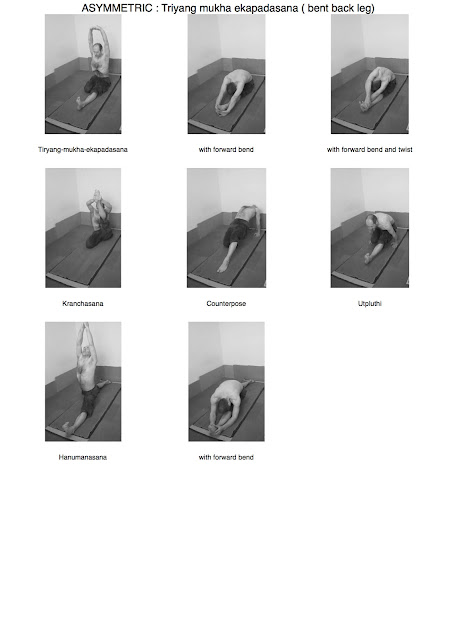 |
| VIDEO LINK |
In Hanumanasana we're stretching the hamstrings on the fount leg and the quadriceps on the back leg so we want to make sure both have received sufficient preparation in earlier subroutines in our practice.
I struggled with hanumanasana for a long time before coming to Vinyasa krama. I credit my ability to enter the posture to the long stays paschimottanasana that we'll see in the seated sequence subroutines.
A long stay is called for in picture 2, the forward bend with the leg bent back, Ramaswami recommends five minutes and that extra time is well spent.
Picture 4 is, I've just realised, an addition of my own, it's a bent back leg version of kraunchasana which we saw in Day 28. I've mistakenly carried this over from ashtanga but it doesn't seem out of place. Here we're stretching the hamstrings as well as the quads, again excellent preparation for hanumanasana.
Although the preceding postures can be seen as excellent preparation for hanumanasana they are all excellent stand alone postures and this is one of my favourite subroutines whether or not I choose to continue on to hanumanasana in that particular days practice or not.
HINTS/TIPS/SUGGESTIONS
Ramaswami stresses here that hanumanasana, the monkey-god posture is particularly challenging and should be practiced with guidance.
Prepare yourself for a year or so working towards this, that prep will include becoming more comfortable in extended stays in paschimmotanasana.
In a sense hanumanasana is also a backbend so that is another area we can work on leading up to this posture.
When you are ready to attempt it, from downward dog you might try stepping through, rocking back on your heel and lowering on to your trailing knee.
Don't step through too far at first, as so often in Vinyasa Krama we enter a pose gently, on the breath and then return to stithi on the breath then enter again a little more deeply, eventually entering for a longer stay which we then precede to deepen with each breath.
Find a place that is comfortable and focus on your breathing keeping both legs engaged.
Eventually you will be able to step through a little further and as you rock back on your heel stretch back with your reclining leg. Again find a point that is comfortable, keep both legs engaged and focus on your breath, the longer you stay the better.
The time will come when you have stretched through and have stretched into the pose far enough to no longer be balanced on your knee, only your hands will be supporting you. Blocks here might be something to consider.
Try engaging the muscles of both legs firmly and keeping them engaged for a count of fifteen second then relax and allow yourself to lower a little deeper. Again caution is advised.
If you overdo it here, you'll pull or at least tweak a hamstring and won't be able to work on the pose for another three to six months, this is not one to rush.
There is a temptation when you almost reach the floor to allow your hip to twist slightly and come down on the side of one buttock, this is a bad idea as it puts tension on the knee.
I found this is a nice posture to work on after practicing eka pada raja kapotasana
NB: These are practice notes that will be tidied up and put into the new edition of my Vinyasa Yoga Practice Book along with the current sequences and subroutines. The book can be freely downloaded HERE. There is a page on Facebook HERE with all the latest sheets and updates. This book is in no way a substitute for Ramaswami's Complete Book of Vinyasa Yoga.
No comments:
Post a Comment
Note: only a member of this blog may post a comment.